Lisa Dawn's Blog: The Princess Blog, page 6
May 11, 2025
Review: Forest Princess
I received an ARC of Forest Princess, the first book in the Forests of Anvrea series by Lucy Winton. This book is the first in a romantasy trilogy about a kingdom where magic is banned. While I appreciate that the book is a quick and easy read for people who are pressed for time, a certain something was missing that prevented me from being compelled to read the next chapter and root for the characters. It's a simple and sweet story without many twists or turns that wraps up too quickly and easily.
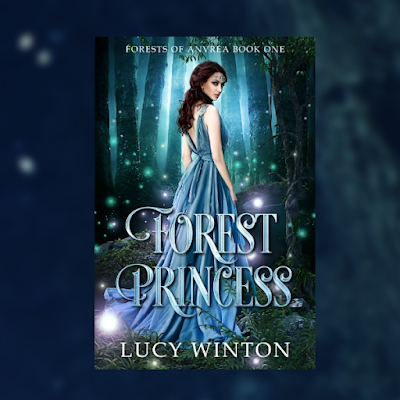
Princess Kerenza is forced to hide her magic from the world due to her father's kingdom-wide ban. She is determined to change the laws when she becomes queen, but there is little she can do about it until then. After she is captured by a group of rebels who know about her magic, she escapes with a group of traveling smugglers. As she gets to know them, she grows feelings for a young man named Edmund, but represses them due to their class difference. During her time traveling with the troupe, she learns more about her own magic and how to wield it to defend herself from future dangers.
This book follows a basic "road trip" formula in which a group of unlikely travelers get to know each other while exploring the surrounding lands. This formula doesn't usually sit well with me because I find it tedious. Although the story is fine for what it is, there's very little action or excitement, even though the main character is supposed to be on the run. Still, I noted several plot similarities to the first book in my own trilogy, with a rebel princess protagonist who wants to restore magic to her kingdom, so I have to give the author props for being on the same wavelength.
Kerenza and Edmund spend a lot of time traveling together, and class differences usually add a lot of romantic tension. However, I felt like I missed most of the chemistry between them. Kerenza needed to outright state in the narration that she had feelings for him for me to realize it as a reader. Even then, I had a hard time seeing it in the story. Although a subtle romantic subplot is not always a bad thing, there wasn't enough of anything else to make up for it. The magic system existed, but was limited to throwing orbs of light. I would have liked to see more variety of powers for something that was considered so rare and dangerous.
While Forest Princess by Lucy Winton is a sweet and straightforward romantasy read, it ultimately fell short for me due to its predictable plot, lack of compelling character development, and underwhelming romance. Despite its engaging premise and relatable protagonist, the story's slow pace and reliance on familiar tropes made it difficult to become fully invested. However, Winton's world-building and magical concepts show promise, and fans of gentle, character-driven fantasies may find something to appreciate here. With some further development and refinement, this series could still reach its full potential within the next two installments.May 5, 2025
Review: The Rose of Versailles (2025)
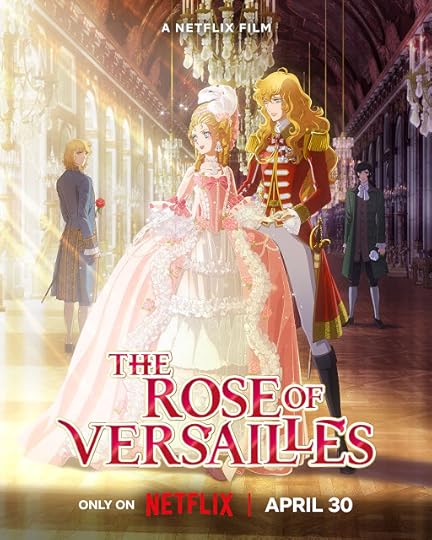
The new adaptation of the 1972 anime retells the story about a woman named Oscar who is trained to be a French soldier to defend Marie Antoinette during the French Revolution. It combines history with fantasy by focusing on real historical figures who lived during the reign of King Louis XVI and the gender struggles of a woman who was raised as a man by no choice of her own. Like the anime, the film covers several decades of French history that continues in text form during the credit sequence. The problem is that the movie has only two hours to cover such a massive timespan, while the anime had 40 episodes. It tries to resolve this with voiceover narrations that cover the major historical events that took place between scenes and music video montages that brush through major events affecting the lives of the main characters with mixed results.
Although I didn't find this movie as entertaining as the series, its biggest strength is the animation. The artists did a spectacular job of recreating the grandeur of the Versailles palace, Rococo fashion, and the sprawling cathedrals and villages of the old French empire. The flower and rose petal theming was as prominent as in the original anime without being distracting, and the character designs were close enough to the original to feel authentic. The music videos made some daring stylistic choices using a lot of symbolism, color, and forced perspective. Sometimes these choices paid off, and other times they didn't. The music reminded me more of '80s synth than modern melodies, but none of the songs were particularly memorable.
Netflix did a good job with the localization. The English dub wasn't as cringeworthy as most anime, and the songs had both English and Japanese singers who were equally talented. The historical context can be appreciated by any culture with an interest in French history. There were a couple of times that it reminded me of Les Misérables , since that was another musical that took place during the French Revolution. My memory of the original anime was a little fuzzy when I watched this film, and the rushed pacing wasn't much help in refreshing it. The one thing it did remind me of was how depressing a story it turned out to be, as the French Revolution was a trying time for everyone involved.
MAPPA's adaptation of The Rose of Versailles is a visually stunning film that, despite its ambitious attempt to retell a decades-spanning story in a condensed format, falls short in fully capturing the essence of the original anime. While the animation and localization are noteworthy, the disjointed musical format and rushed pacing compromise the narrative's impact. Nonetheless, fans of French history and the original series will appreciate the film's grandeur and thematic fidelity, even if it doesn't entirely live up to expectations. Ultimately, The Rose of Versailles movie serves as a nostalgic reminder of the timeless story, rather than a definitive retelling.
May 3, 2025
Review: Insomniac's Curse
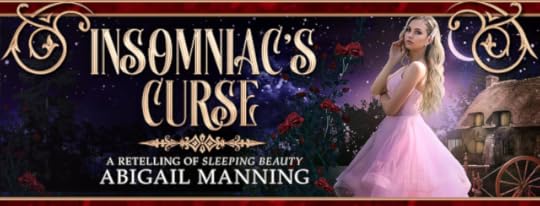
Kaliope is an innocent maiden living in the woods, being raised by her three spinster aunts. She has a hard time sleeping at night, and for good reason. When she falls asleep, she has episodes where she loses control of her body and launches into violent attacks on the villagers. Her aunts have done their best to hide her as the source of the attacks, but the more frequent the episodes get, the more difficult that becomes. Meanwhile, a royal knight named Daniel is put in charge of protecting the hidden princess from the beast ensnaring the village. Things get more complicated after he deduces that she is both the maiden and the beast. Now he needs to figure out a way to protect her from herself.
Although Kaliope's Dr. Jekyll and Mr. Hyde complex is fascinating, I think Daniel is actually my favorite character in the book. I thoroughly enjoyed the chapters that were told from his perspective because it was easy to relate to his intelligence and empathy as he slowly discovered Kaliope's secret and decided to do the right thing, even though it would have been so easy to just restrain in her innocent awake state to avoid letting the moster come out in her sleep. He is so patient and understanding, explaining everything to her as he learned new secrets and protecting her from the greedy fingers of Jamal, an innkeeper's son who was determined to marry her.
Although Kaliope's dissociative episodes may not be relatable to most readers, her feelings for Daniel really make her shine as a character. She is incredibly sweet and terrified at the thought of harming anyone. When Daniel learns her secret and still doesn't see her as a monster, she grows incredibly close to him and even trusts him enough to watch her sleep. They bond over a mutual love of books and become more and more determined to protect each other as the story unfolds. It's heartwarming to see how much Daniel is willing to endure for Kaliope's sake. When the big twist is revealed at the end of the book, all I wanted as a reader was for both of them to be okay and find a way to be together.
Insomniac's Curse is a daring new reimagining of "Sleeping Beauty" that will transport you to a world of magic, romance, and suspense. With its unique blend of mystery, adventure, and tender moments, this book is sure to delight fans of fantasy and fairy tale retellings. Abigail Manning's masterful storytelling weaves a spell that will keep you enthralled until the very end. If you're looking for a relaxing yet thrilling read, look no further than Insomniac's Curse.
April 28, 2025
All the New Winx Club Transformations Have Been Revealed!
Nowadays, reboots of nostalgic properties have become so commonplace that it's difficult to get excited anymore. In the case of Winx Club, an animated reboot, albeit CGI, is more of a correction/apology for the horrendous live-action remake that came out four years ago. Fate: The Winx Saga had none of the magic, visuals, or whimsy that made Winx Club such a beloved franchise. Rainbow SpA issued a different type of apology last year in the form of a completely original magical girl series. Mermaid Magic brought back the charm and nostalgia of magical girl transformations, fantasy, and innocent romance that Fate was missing. Now, they are redirecting their attention back to their original fans by focusing on their newest iteration of Winx Club, which is allegedly coming to Netflix this fall.
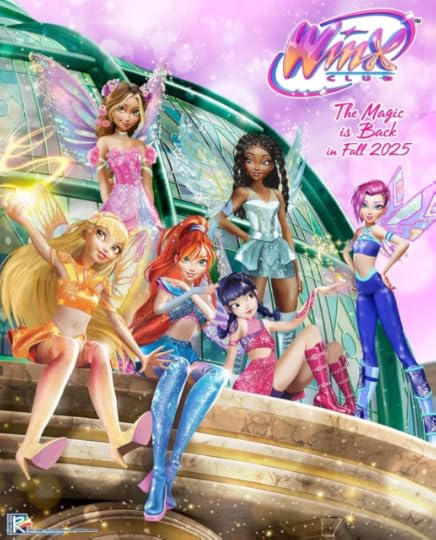
Although Rainbow launched a short teaser for the 2025 Winx Club reboot late last year, there was very little revealed about what the girls would look like in their fairy forms when they unleash the full magic of Winx. Rainbow wisely decided to build up to this gradually by releasing a new transformation sequence every few days throughout the month of April until all six girls were revealed in their full Winx fairy glory. This was a clever marketing technique because it allowed fans time to absorb each transformation sequence individually and share their thoughts with each other over an extended period of time instead of being overloaded with all of them when the show premieres.
The first two reveals were Flora, the fairy of nature, and Tecna, the fairy of technology. Although I generally like Flora better as a character, I have to admit that I prefer Tecna's new transformation sequence over Flora's. I liked the beginning of Flora's sequence, in which she blooms out of a lovely pink lotus blossom. In general, it was a very nice touch that each of the six transformation sequences began with the girls popping out of some sort of spherical item that relates to their element. However, once she starts swinging around on vines and doing gymnastic moves, it feels less like a transformation sequence and more like an acrobatics show. If you want to see what a real floral-themed transformation sequence should look like, I recommend checking out Cure Felice's transformation from Witchy Precure, which just might be my favorite magical girl transformation sequence of all time.
Tecna makes good use of her technology powers by typing on a magical computer, as though she is coding her own transformation. When she uses two fingers to zoom in on her eye like you would do on a smartphone or device, it draws attention to how far technology has come since Winx Club premiered in 2004. It makes perfect sense that Tecna would remain on the cutting edge. I also liked that her sequence draws more attention to her wings appearing than Flora's did, since the wings are the most important part of a human-to-fairy transformation. On the other hand, I wish they had made her wings look a little different from other fairies. In the original show, they appeared to be metal green wires protruding from her back. That made her stand out from the others, while her wings here look more homogenous.
The next two reveals are Musa, the fairy of music, and Stella, the fairy of the sun and moon. Between these two, Stella is the clear winner. Musa's transformation looks like a carbon copy of Flora's, with the vines being replaced by bars of music. I liked how it looked like she was listening to the theme song on headphones at the beginning of her sequence, since music is a big part of the Winx transformations, but everything after that is pretty mid. Like Flora, she has very little attention placed on her wings. Stella, on the other hand, has some gorgeous transitions between flipping her powers from day to night by switching the sun and the moon with a flick of her wrist. She bursts with light out of the night sky, representing the importance of her two elements. It's cleverly orchestrated and does a great job of showing off her solar-powered energy.
The final two reveals were Aisha, the fairy of waves, and Bloom, the fairy of the everlasting Dragon Flame, which only launched minutes ago. Even though Bloom is the main character of the Winx Club series, Aisha was given a compelling backstory with more interesting arcs than any other character in the show after she was introduced in the second season. One of the changes for the reboot series is that she will be introduced as a core member of the cast from the very beginning. Her importance is reflected by her lovely transformation sequence, which shows her splashing around in and out of the water and controlling the waves around her. Fans of The Little Mermaid will appreciate the Ariel "hair flip" reference in the middle of the transformation. Bloom, on the other hand, looks off to me. Her sequence had plenty of fire and suited her personality, but her face looked, especially at the end. As I watched it, I just kept thinking, "That's not Bloom."
Now it's your turn! Which of the six Winx Club transformation sequences is your favorite? Do you think Tecna's tech-savvy transformation takes the cake, or does Stella's solar-powered sequence shine brightest? Perhaps Aisha's aquatic transformation or Flora's nature-inspired sequence stole the show for you? Let me know in the comments below! Share your thoughts on the reboot and which transformation sequence you think best captures the magic of Winx Club, and stay tuned for the new reboot coming to Netflix next fall.
April 27, 2025
Review: Lake of the Wild Swans
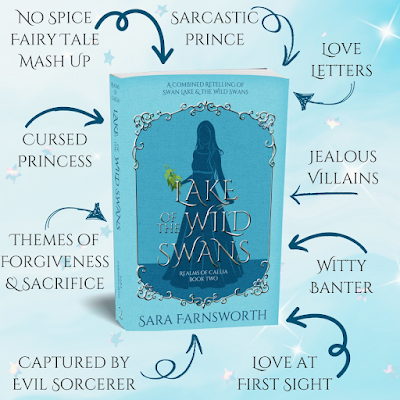
Princess Odette is a teenager with social anxiety who is intimidated by all the attention she receives at a royal ball, first by a flirtatious masked pirate and later by a creepy duke. When she realizes the costumed pirate is actually Prince Lander and that he is sincere in his flirtations, she begins to fall for him, enraging the duke, who is actually a sorcerer named Rothbart. When Odette's seven brothers catch Rothbart using magic on Odette, he transforms all eight of them into swans and captures them in a faraway castle with a lake. Only Odette recovers her human form each night, but if she leaves the vicinity of the lake as a human, she will die. The only way to convince Rothbart to remove the spell is to marry him, which is unthinkable.
The characters in this book are a lot of fun. Although Lander's flirting gets kind of irritating after a while, he has a great sense of humor and serves as a terrific complement to Odette's shyness. Her brothers are also pretty funny while trapped in the bodies of swans because they honk and poke at any man who tries to hit on Odette, whether it's Rothbart or Lander. I did wish they could do more to show their individual personalities instead of always acting as a unit, but that can be difficult when they can't communicate for most of the book. Odile was underused as a character. I liked that she was in this, but she could have posed a much bigger threat than she did to make the story align better with the "Swan Lake" ballet.
The minor changes made to both fairy tales were mostly for the better. I appreciated that the parameters of breaking her brothers' spell were changed from not being able to talk at all until she finished sewing them all shirts made of nettles to simply not being able to talk about her task. Losing her voice as soon as her prince discovers her would have made this book too similar to "The Little Mermaid," which was also teased at the end for a future Realms of Caelia novel. Rothbart's magic is explained in detail, leaving no stone unturned. Alora, the protagonist from Beauty in the Tower, makes good use of her magical knowledge to aid Odette as much as possible in her mission to escape Rothbart and break the spells on her brothers and herself.
Lake of the Wild Swans is an engaging retelling of two classic fairy tales, seamlessly woven together with magic, romance, and humor. Sara Farnsworth's Realms of Caelia series continues to impress, with this installment offering a fresh take on "Swan Lake" and "The Wild Swans." The characters, particularly Odette and her swan brothers, are delightful and memorable, and the story's unique blend of fairy tale elements and magical world-building makes for a compelling read. While some characters, like Odile, could have been utilized more effectively, the book's strengths far outweigh its weaknesses. Overall, Lake of the Wild Swans is a must-read for fans of fairy tale retellings and clean romance, and I eagerly look forward to the next installment in the series.
April 20, 2025
Review: The Princess Knight
The latest ARC I received from NetGalley was The Princess Knight by Cait Jacobs. This book has a generic-sounding title, which made me expect something along the lines of the overdone warrior princess trope. I was pleasantly surprised to find that it actually had a feminine protagonist who wasn't much of a fighter. The book is actually a stealth medieval retelling of Legally Blonde, particularly the Broadway version. Being a huge fan of the musical, I had a lot of fun catching the many references to it peppered throughout the book. For marketing purposes, I do wish the title made it more obvious that this is a retelling because I think that would help widen its reader appeal. I'm not sure exactly what it should be called to do that, though. Royally Blonde? Legally Knighted? Legally Princess?
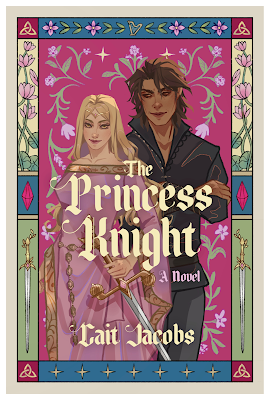
Princess Clia is in an arranged marriage with Prince Domhnall to forge an alliance between their kingdoms. She is blindsided when Domhnall unexpectedly breaks off the engagement for someone who would be a more "serious" leader. In a valiant attempt to prove she has what it takes to lead, Clia follows Domhnall to a prestigious military academy where she trains in the art of warfare on her own terms, fancy dresses and all. During her attendance, she grows closer to Ronan, one of Domhnall's knights, who feels awful about how his friend snubbed her. He helps her with her training and looks out for her during the trials and tribulations she faces at the school.
This book is so similar to Legally Blonde that fans of the movie or play can easily predict everything that happens in it, which might be a drawback for readers who enjoy plot twists. Some scenes felt like they were taken directly from the stage show. Every character has an equivalent in this book, which makes it easy to know what to expect from them. One of my favorite characters was Niamh, the "Vivienne" equivalent. As Domhnall's new fiancée, she sees Clia as a threat at first, but later comes to respect her as a peer and realizes that Domhnall may not have been as great as she initially thought. Clia has a handmaiden who takes on the same role as Paulette whom I liked as well.
Since this is a war story, there is quite a bit of action and violence in it, especially toward the end, which is not ideal for fans of the traditionally safe narrative of Legally Blonde. The war element gives it some semblance to Mulan , but without the crossdressing. In fact, Clia is a refreshingly feminine character who finds ways to use her femininity to her advantage in battle. This makes The Princess Knight stand apart from the myriad of other stories about tough-as-nails battling princesses from the last few decades. In a refreshing throwback to older feminist media, Clia must work hard and leave her comfort zone to become a great leader rather than being naturally gifted.The Princess Knight is an uplifting and clever retelling of Legally Blonde, transporting the beloved story to a medieval setting with a refreshingly feminine protagonist. Cait Jacobs' writing is engaging and fun, with nods to the original musical that fans will appreciate. While the story follows the same beats as the original, the addition of a war storyline adds a new layer of depth and action. Clia's journey from pampered princess to capable leader is inspiring, and her femininity is portrayed as a strength rather than a weakness. Overall, this book is a great fit for fans of fairy tale retellings, strong female protagonists, and a dash of humor and romance. If you're looking for a fun and lighthearted read with a medieval twist, The Princess Knight is definitely worth checking out.
April 13, 2025
Review: Rapunzel's Gambit
Rapunzel's Gambit by Mary Mecham is the second ARC I received from the upcoming All That Glitters mult-author series of fairy tale retellings. Though it is meant to be a retelling of "Rapunzel," it has a lot more in common with a book from 1990 called Dealing with Dragons, which was about a princess who was tired of her royal duties and ran away to live with a dragon. This version of Rapunzel is feisty, aggressive, and a bit spoiled. A far cry from an innocent maiden who was kidnapped as a child, she is raised by a wealthy king and believes she can do a better job running the kingdom than him due to his overtaxation of the people. It follows many of the modern princess tropes from recent Disney remakes.
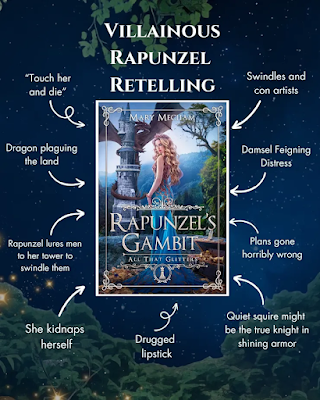
Princess Rapunzel's favorite hobby is causing trouble for everyone around her. She is a shameless flirt, a shrewd chess player, and a royal rebel. Her father is frustrated with her antics and decides to marry her off to the first person who can slay the dragon plaguing their kingdom. Refusing to be tied down, Rapunzel decides to stage a kidnapping and runs away to make a deal with the dragon. Pollox is amenable to her terms and provides her with a luxurious enchanted room that can be turned into a prison cell to trick noble heroes into rescue attempts. The so-called "heroes" can be held for ransom to add to the dragon's hoard. Rapunzel has great fun conning the knights until she is reunited with a squire named Griffin, who is a cut above the rest and seems more sincere in his attempts to free her.
Rapunzel's Gambit has an odd love triangle, as Rapunzel's relationship with the dragon is complicated. She knowingly volunteers to be part of his hoard for her schemes but then becomes concerned that Pollox might think of her as a possession. Isn't that exactly what she signed up for? Although Rapunzel's actions of lying and cheating other kingdoms are admittedly devious, she never repents for her actions or learns any moral lesson. Instead, she is presented as a "Robin Hood" figure whose conning is justified because she gives her earnings to the less fortunate. Another thing that bothered me is that the book used the same tired trope as most stories from this author in which a trustworthy character has a sudden and unexpected turn and starts monologuing in detail about their wicked intentions.
With all that said, I had a fun time reading this book. The plot twists were developed well. Most of the time, I had no idea what would happen next. The characters are unique and interesting, and the plot is pretty original for a fairy tale retelling. Fans of the movie Damsel would love this book, as it takes a classic story in a modern new direction. I probably would have enjoyed it more if I didn't struggle so much with the questionable morals of the main character. The love triangle was also very compelling. I genuinely had no idea who Rapunzel would end up with. The father/daughter element was a little weaker. I thought both Rapunzel and the king were to blame for their actions, and their resolution felt forced. Still, it was nice to include some family values in a book like this.
Rapunzel's Gambit is a unique and engaging take on the classic fairy tale, with a feisty and complex heroine at its center. While the book's moral ambiguity and questionable character motivations may be off-putting for some readers, fans of modern fairy tale retellings and strong female protagonists will likely enjoy the twists and turns of Rapunzel's story. With its blend of humor, adventure, and romance, this book is a fun and compelling read, even if it doesn't always toe the line of good decision-making. If you're looking for a fresh take on a classic tale with a dash of sass and wit, Rapunzel's Gambit is definitely worth checking out.April 11, 2025
Yes, There Was Really a Family Sitcom About Snow White in the '80s
The recent talk about live-action "Snow White" adaptations has brought to light some older ones that may have otherwise been lost to time. One such example is The Charmings, a family sitcom from 1987 about Snow White and her family waking up after a thousand-year sleep in modern-day Burbank and adjusting to life in the real world. It gives off major Enchanted vibes, but a lot more campy. Even watching the show today feels like a fever dream, so I can only imagine how people who grew up with it as a faint memory would still question its existence. All 21 episodes of its limited run are available to watch on YouTube in their full hokey glory.
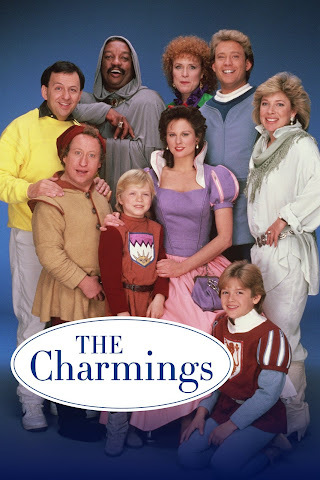
This version of Snow White many not pick up a sword and lead a revolution against her wicked stepmother like most modern interpretations, but she does learn to become a career woman by designing dresses for a successful fashion company. She lives with her husband, Eric Charming, their two children, Thomas and Cory, a dwarf named Luther, and the infamous stepmother, Lillian, who channels Endora from Bewitched. In this version of the story, Snow and Eric decide to put aside their prejudice toward Lillian for poisoning and cursing them and treat her as a member of the family. She has a confusing relationship with her sassy mirror, who makes snarky remarks about her morally questionable decisions and obsession with making the Charmings' lives miserable.
Although it's been parodied frequently, the original "Snow White" story is about the furthest thing from a comedy, which makes a lot of the humor in this show in poor taste. Once Upon a Time had a better concept of turning the story into a riveting drama filled with high tension and stakes. Most of the jokes in the first season revolve around Snow or Eric looking at modern conveniences and saying "I don't know what this is." In the second season, Snow evolves into a modern '80s woman portrayed by a different actress, while Eric still struggles to adjust to life in the 20th century. The most bizarre element of the show is that they continue letting Lillian live with them despite her constant attempts to poison the family, although she begins to soften over the course of the show.
The Charmings came out the same decade that Shelley Duvall established her star-studded Faerie Tale Theatre series of retellings and contains many references to other stories. The interior of the Charming house looks like every other sitcom set, but the exterior is a white castle that resembles the one from the 1937 Disney movie. The second season opening uses early computer effects to combine images of the cast with campy cartoon settings. In the first season, the family wore corset dresses and armor before becoming more acclimated to traditional '80s fashion. Other fairy tale characters occasionally made cameos, but they didn't always work. For instance, it was hard to believe that Cinderella had loose morals when she was always locked in the attic doing chores and relied on magic for just one night out.
The Charmings is a campy 1980s sitcom that offers a unique and humorous take on the classic Snow White fairy tale. By transplanting the beloved characters into a modern-day suburban setting, the show creates a fascinating blend of fantasy and reality. Despite its questionable humor and bizarre plot twists, the series charms with its nostalgic '80s vibe and memorable characters. For fans of retro TV and fairy tale adaptations, The Charmings is a must-watch, offering a delightful blend of humor, heart, and campy charm. With all 21 episodes available on YouTube, anyone can now experience the quirky adventures of the Charming family and their eccentric lives in Burbank.
April 6, 2025
Snow White and the Three Stooges Is the Best Live-Action Snow White You've Never Seen!
After Disney has destroyed their legacy with one of the worst live-action adaptations of "Snow White and the Seven Dwarfs" in history, it seems like a good time to explore other options. Snow White and the Three Stooges is a 1961 musical that retells the fairy tale with the famous comedian entertainers Larry, Curly, and Mo, better known as the Three Stooges, taking the place of the seven dwarfs. The title might make the movie sound like a tongue-in-cheek comedy, but from the moment it opens with its classic storybook illustrations, it is clearly something special. Far from a comedy, this film treats every picture-perfect fairy tale moment with the utmost sincerity, from the tragic loss of the king to the prince's found family. It stars Olympic figure skater as Snow White and incorporates graceful ice choreography into the film's picturesque winter aesthetics.
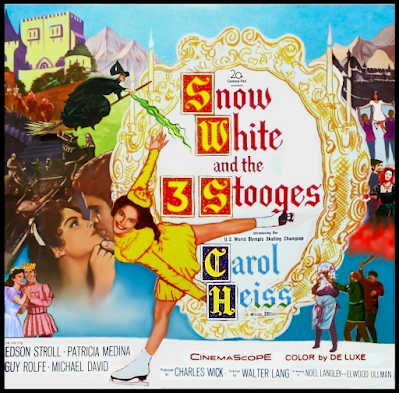
Snow White and the Three Stooges starts out similarly to the fairy tale, with a beautiful and kind-hearted princess whose father remarries a vain queen. The opening number is a gorgeously choreographed vintage ice skating spectacle with old-timey nostalgia feels. When the king falls ill and passes away, Snow White is imprisoned by the jealous queen, who fawns over her magic mirror in glamorous gowns and jewels. The unlucky princess escapes an assassination attempt and seeks refuge with three traveling performers and their ward, Quatro, a ventriloquist who was taken under their care as a child. They move into the unoccupied cottage of the seven dwarfs, where Snow White and Quatro fall in love. However, the queen is out for blood, and the two must fight to take back their kingdoms before they can be together.
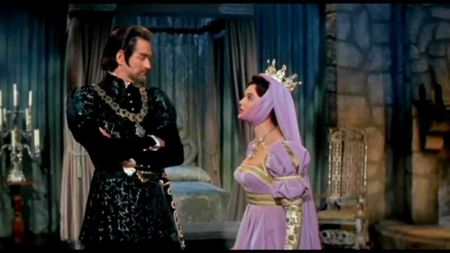
Filled with lavish sets, costumes, and musical numbers, this movie is a true homage to the Golden Age of Hollywood. In the days before CGI, it is impressive how an entire fairy tale world could be hand-crafted from scratch. The movie portrays a multitude of places in the castle, from the royal chambers to the dungeons to the portcullis, and all of it looks and feels like a place I'd want to visit. The woods where Snow White and Quatro fall in love are nothing short of enchanting. The ice skating sequences are breathtaking, particularly an extended dream sequence where it looks like the entire cast of the film is skating on a mystical black lake suspended somewhere in space and time. While Snow's outfits are humble and sweet, the evil queen gets the true royal treatment with glittering medieval gowns that are surprisingly understated when compared with other interpretations of the story.
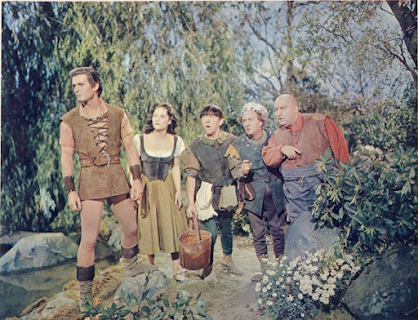
While the Three Stooges serve an important role in the story as Quatro's surrogate parents and Snow White's protectors, they never overshadow the main characters or downplay the danger they are in. They add a few moments of comic relief to the story when levity is needed, particularly when one of them finds a magical wish-granting sword, but there are no egregious changes to the original fairy tale. Their role as Quatro's caretakers provides some much-needed backstory for the prince and how he comes to know Snow White. In addition to the humor, Quatro has some impressive action sequences when he leads a raid against the evil queen. All in all, every role in this movie is well-balanced and used to its maximum potential.
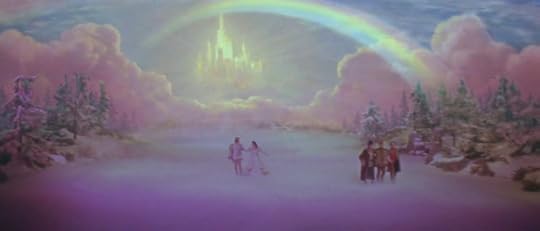
Snow White and the Three Stooges is a charming and enchanting musical retelling of the classic fairy tale, far removed from its comedic title. With its picturesque settings, lavish costumes, and impressive ice choreography, this 1961 film is a true homage to the Golden Age of Hollywood. The Three Stooges add a delightful touch to the story without overshadowing the main characters, and the film's balance of action, romance, and comedy makes for an engaging watch. If you're looking for a nostalgic and family-friendly adaptation of "Snow White," this musical might just be the perfect fit.
Review: The Princess Swap - Rapunzel and the Sea Witch (or, The Little Mermaid and the Tower)
Rapunzel and the Sea Witch (or, The Little Mermaid and the Tower) by Kim Bussing is the third book from the traditionally published series The Princess Swap. I received an ARC of this book from NetGalley. Unfortunately, I have not read the second book in the series yet, but I don't think I missed anything important since each book can be enjoyed as a standalone. Like Cinderella and the Beast, this book contains a role reversal between two classic princesses. In this case, the swap occurs between "The Little Mermaid," whose name here is Hana, and the self-titled "Rapunzel." Since these are two of my favorite fairy tales, I'm going easy on this one. While I think this book would be an enjoyable read for its younger target audience, I'm not sure I'd recommend it for teens and adults who also enjoy fairy tales.
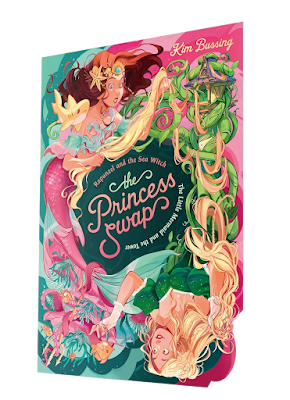 Hana, the youngest mermaid of six sisters, was always curious about the human world. She also hopes to stop a dangerous storm from swallowing her peaceful undersea kingdom of Avalon. Meanwhile, Rapunzel is a girl who was kept locked in a tower by the calculating Lady Grimm, who told her that her curse posed a danger to herself and others if she left. However, it is never made clear exactly what her curse is. When Hana secretly steals a contract from the sea witch, Madame Divine (cleverly named after the drag queen that Disney's Ursula was based on), she unexpectedly finds herself standing on two legs, locked in a tower. Meanwhile, Rapunzel ends up in Madame Divine's lair and makes an agreement to trade her voice for the chance to travel freely without her curse harming those around her. The two girls encounter two boys on their travels, a prince who fell off a ship, and Jack, of magic beanstalk fame, but there aren't any direct references to romance.
Hana, the youngest mermaid of six sisters, was always curious about the human world. She also hopes to stop a dangerous storm from swallowing her peaceful undersea kingdom of Avalon. Meanwhile, Rapunzel is a girl who was kept locked in a tower by the calculating Lady Grimm, who told her that her curse posed a danger to herself and others if she left. However, it is never made clear exactly what her curse is. When Hana secretly steals a contract from the sea witch, Madame Divine (cleverly named after the drag queen that Disney's Ursula was based on), she unexpectedly finds herself standing on two legs, locked in a tower. Meanwhile, Rapunzel ends up in Madame Divine's lair and makes an agreement to trade her voice for the chance to travel freely without her curse harming those around her. The two girls encounter two boys on their travels, a prince who fell off a ship, and Jack, of magic beanstalk fame, but there aren't any direct references to romance.From the summary alone, it should be clear that a lot is happening in this book. Most of it is very interesting, especially for fairy tale fans, but there's very little explanation for any of it. How do Rapunzel and Prince Oliver breathe underwater when they aren't merfolk? Why did Hana immediately find a way out of the tower when Rapunzel lived there her entire life? What is Rapunzel's curse? Why does the storm pose a threat to Avalon? Readers need to go with the flow without questioning anything. If you do that, it can be a fun ride. This story reminded me a lot of Into the Woods, and it suffers from many of the same flaws, including a bloated cast and too many references to other stories. Not only does it depend on readers already knowing the stories of "The Little Mermaid" and "Rapunzel," but it also features characters and plot elements from "Jack and the Beanstalk."
Another thing this book has no shortage of is villains. Aside from Madame Divine and Lady Grimm, this entry introduces a new character called the General, who poses the biggest threat of all. The story already had plenty of conflict from the little mermaid's wicked sea witch and Rapunzel's lying maternal figure, but as a modern princess story, the writer probably thought it was necessary to include a male villain. The General is primarily a psychological threat, spreading prejudice between humans and merfolk to start unnecessary wars between them. Although I was intrigued upon learning his true identity, it would have packed a bigger punch if the story hadn't been so convoluted. The threat of the storm, Rapunzel's supposed curse, and various hostages gave the main characters plenty to deal with. Hana, Rapunzel, Jack, and Prince Oliver all prove themselves as brave and worthy protagonists who make excellent role models for younger readers of this series.
Rapunzel and the Sea Witch is a creative and action-packed retelling of two classic fairy tales, with a unique role reversal and plenty of exciting plot twists. While it may be enjoyable for younger readers, the convoluted storyline and lack of explanations may make it less appealing for teens and adults. The characters are well-developed and make for great role models, but the story suffers from a bloated cast and too many references to other tales. Overall, fans of fairy tale retellings and adventure stories may find this book entertaining, but others may find it overwhelming. The book is most suited for its target audience of middle-grade readers between the ages of 8 and 12.



